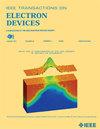Impact of the Endurance Measurement Methodology on Ferroelectric Field Effect Transistor Under the Capacitive Nondestructive Read
IF 2.9
2区 工程技术
Q2 ENGINEERING, ELECTRICAL & ELECTRONIC
引用次数: 0
Abstract
In this article, the impact of the measurement delay and connection to the body contact on the reliability of the ferroelectric field effect transistor (FeFET) under the capacitive nondestructive read mode is studied. Specifically, the endurance characteristics of the FeFET’s gate-to-source/drain capacitance are analyzed. The study is performed on 28-nm bulk Si FeFET technology, with body contact either grounded or floating. We find that the FeFET device exhibits an erase after program delay, where as the number of pulses during the bipolar stress increases, the ferroelectric switching of the FeFET reduces. During the memory window (MW) evaluation (after the bipolar stress), the system setup delays are longer than the erase after program delay in the actual operation. Hence, the ferroelectric switching is restored showing a full MW. The results indicate that the presence of this erase after program delay imposes a minimum stress frequency on the device, which in turn increases the measurement time. Furthermore, the result points toward the need to re-evaluate the standard endurance measurement practice.电容式无损读取下铁电场效应晶体管寿命测量方法的影响
本文研究了在电容式无损读取模式下,测量延时和与体接触的连接对铁电场效应晶体管(FeFET)可靠性的影响。具体来说,分析了ffet的栅源/漏极电容的持久特性。该研究采用28纳米体硅ffet技术,身体接触接地或漂浮。我们发现,在程序延迟后,ffet器件表现出擦除现象,其中随着双极应力期间脉冲数的增加,ffet的铁电开关减小。在内存窗口(MW)评估期间(双极应力之后),系统设置延迟比实际操作中的擦除后程序延迟更长。因此,铁电开关恢复显示出一个完整的毫瓦。结果表明,程序延迟后擦除的存在对器件施加了最小应力频率,从而增加了测量时间。此外,该结果指出需要重新评估标准耐力测量实践。
本文章由计算机程序翻译,如有差异,请以英文原文为准。
求助全文
约1分钟内获得全文
求助全文
来源期刊

IEEE Transactions on Electron Devices
工程技术-工程:电子与电气
CiteScore
5.80
自引率
16.10%
发文量
937
审稿时长
3.8 months
期刊介绍:
IEEE Transactions on Electron Devices publishes original and significant contributions relating to the theory, modeling, design, performance and reliability of electron and ion integrated circuit devices and interconnects, involving insulators, metals, organic materials, micro-plasmas, semiconductors, quantum-effect structures, vacuum devices, and emerging materials with applications in bioelectronics, biomedical electronics, computation, communications, displays, microelectromechanics, imaging, micro-actuators, nanoelectronics, optoelectronics, photovoltaics, power ICs and micro-sensors. Tutorial and review papers on these subjects are also published and occasional special issues appear to present a collection of papers which treat particular areas in more depth and breadth.
 求助内容:
求助内容: 应助结果提醒方式:
应助结果提醒方式:


